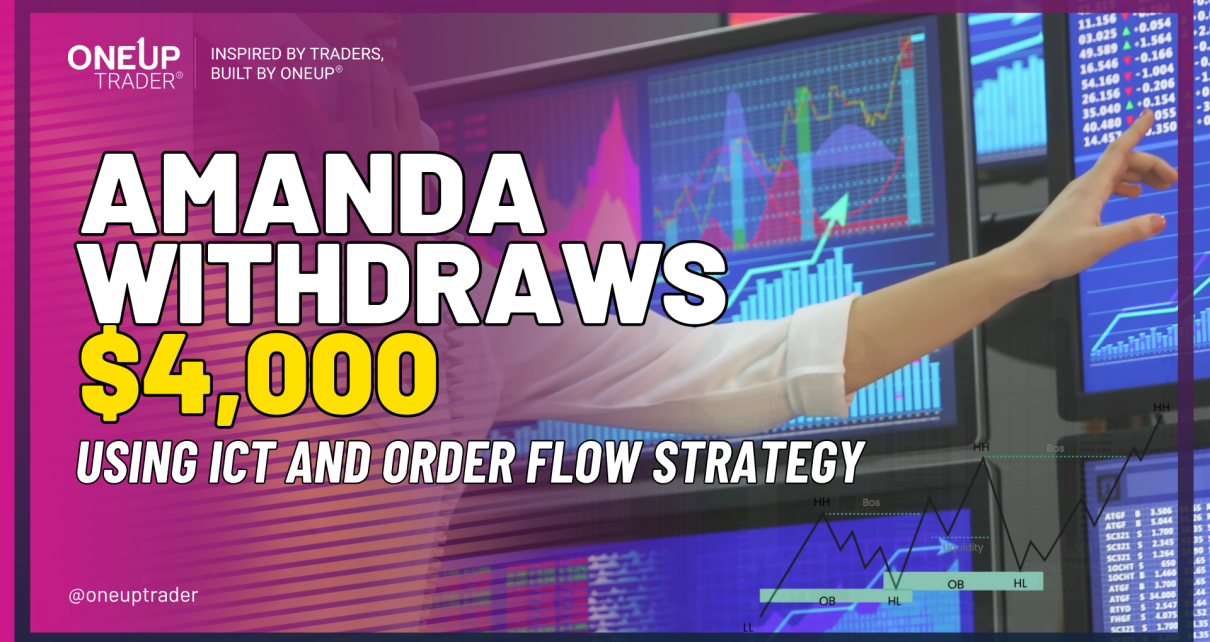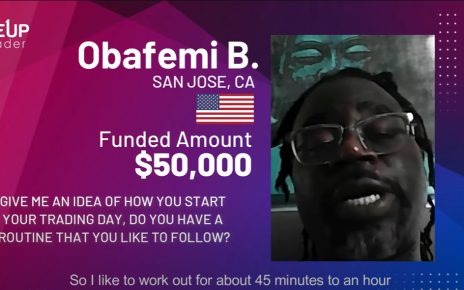Introduction
Amanda L. from Malden, Massachusetts, knows what it means to manage complex projects under pressure. As a full-time project manager, she’s spent years coordinating deadlines, resources, and teams. Now she’s applying those same organizational skills to the markets.
At 41, Amanda recently withdrew $4,000 from her OneUp Trader account after 21 days of trading, bringing her total withdrawals to $5,500 across her multiple accounts. Amanda has been trading for over six years, steadily improving while maintaining her full-time career.
“Financial freedom,” she states when asked why she chose trading. It’s a goal that drives many, but Amanda’s systematic approach and discipline set her apart from traders who rely on hope rather than a well-crafted trading plan.
The ICT and Order Flow Edge
Amanda’s trading strategy combines ICT (Inner Circle Trader), a trading methodology developed by Michael J. Huddleston, designed to help retail traders understand and align with the strategies used by institutional players, often referred to as “smart money.” Rather than relying on traditional indicators, ICT focuses on core market mechanics such as liquidity zones, market structure, order blocks, and fair value gaps. These concepts highlight where large financial institutions are likely to enter or exit positions, often using retail trader behaviors, like stop-loss clustering, to their advantage. ICT strategies such as the “Power of Three” (accumulation, manipulation, and distribution) and time-based trading around London and New York sessions are key tools in this framework.
Amanda also focuses on markets she understands rather than spreading herself across multiple instruments. She trades the Nasdaq, both mini and micro contracts, mainly during the open of the US session.

Performance Analysis

With nearly 600 trades, Amanda has proven her strategy works across different market conditions.
Her 60.74% win rate, combined with her ability to keep average losses manageable, shows solid risk management. While her average loss is slightly larger than her average win, her higher win percentage means she is able to achieve a positive profit factor.
The hold times reveal something important about Amanda’s trading discipline. Most struggling traders hold losing trades for too long, hoping they’ll recover, while cutting winning trades short out of fear they’ll give back profits. Amanda does the opposite; she basically holds her losing trades (4 minutes 10 seconds) and her winners (3 minutes 1 second) the same. We can take from this that she’s following a systematic exit strategy rather than making emotional decisions. She’s likely using predetermined stop losses and profit targets, allowing both winning and losing trades to ‘complete’ rather than making decisions on the fly.
Managing Emotions and Goals
Despite being as systematic as possible, Amanda honestly acknowledges her biggest challenge: “Get emotional sometimes, so I should shut down the platform after reaching a goal.”
Her challenge of becoming “emotional” is common among traders. Emotional trading occurs when the trader’s self-control to stick to a strategy is overcome by an impulse, for example: entries, premature exits, or over‑leveraging. Fear triggers flight—avoiding trades or exiting winners too soon—while greed drives excessive risk. Traders must learn to ‘let go’ of outcomes, focusing only on what they can control: their plan and risk parameters. Techniques such as staying aware, journaling emotional states, and following predetermined rules help cultivate discipline. Over time, consistent mental habits foster resilience, turning trading into a game of probabilities rather than gut reactions and hope.
OneUp Trader Experience

Amanda discovered OneUp Trader through word of mouth and chose the platform for a practical reason: “no hidden fees after passing.” Her experience has been largely positive, rating OneUp Trader 7 out of 10 and describing it as “one of the best.”
Compared to other funded trading companies, Amanda appreciates OneUp’s straightforward approach: “too many random rules” at other companies frustrated her, while OneUp’s clear structure aligns with her preference for organized, transparent processes.
Her customer support experience has been “very satisfied,” and she’s “very likely” to recommend OneUp Trader to others as she told us in her question and answer sheet before receiving funding.
The Path Forward
Amandas short-term goal is to “Make enough to withdraw” so as you can see, she doesn’t want to complicate things.
Long-term, she aims to quit job and trade fulltime which can be very risky but as long as a person treats trading like a business, it is possible. Gamblers and psychologically uncontrolled people don’t progress in this.
Amanda’s combination of professional discipline, strategy development, and honest self-assessment positions her well in the markets.
As she continues balancing her career with trading, Amanda demonstrates that funded trading can provide a realistic path toward financial independence for those willing to approach it with seriousness and discipline.
We are excited to see what she will do next!





